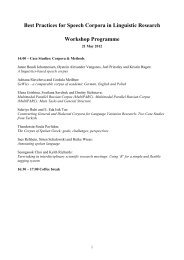96 • 2011 - Hamburger Zentrum für Sprachkorpora - Universität ...
96 • 2011 - Hamburger Zentrum für Sprachkorpora - Universität ...
96 • 2011 - Hamburger Zentrum für Sprachkorpora - Universität ...
You also want an ePaper? Increase the reach of your titles
YUMPU automatically turns print PDFs into web optimized ePapers that Google loves.
of content to language service providers, further<br />
distribution to translators, etc. To organize this process<br />
there is a need to improve standards and better integrate<br />
them. Metadata plays a crucial role in this respect, as we<br />
will discuss later.<br />
Content itself is becoming more complex and fast<br />
changing - and localization approaches need to be<br />
adapted accordingly. In the area of localization, many<br />
standards have been developed: for the representation of<br />
content in the translation process, for terminology<br />
management, translation memories etc. The gap here is to<br />
understand how the standards interplay. This is not an<br />
easy task, since sometimes there are competing<br />
technologies available. Hence, currently there are quite a<br />
few initiatives dedicated to interoperability in the<br />
localization area, including the integration with web<br />
content creation and machine translation.<br />
4.4. Machines<br />
For machines, that is applications based on language<br />
technology, the need for standardization esp. related to<br />
metadata and the localization process is of outmost<br />
importance. Language resources are crucial in this area,<br />
including their standardized representation and means to<br />
share resources. The META-SHARE infrastructure<br />
currently being developed is expected to play an<br />
important role in this area.<br />
While discussing developers, creators and localizers,<br />
machine translation has been mentioned already. It has<br />
become clear that a close integration of machine<br />
translation technologies to these areas is a major<br />
requirement for the better translation quality.<br />
Machines play a crucial role in building bridges between<br />
smaller and larger languages, and to change the picture<br />
about “languages on the web” that we mentioned at the<br />
beginning of this paper.<br />
4.5. Users<br />
Users normally have no strong voice in the development<br />
of multilingual or other technologies. At the<br />
MultilingualWeb workshops, it became clear that the<br />
worldwide interest in multilingual content is high, but<br />
significant organizational and technical challenges need<br />
to be approached for reaching people in continents such<br />
as Africa and Asia.<br />
Multilingual social media are becoming more important<br />
Multilingual Resources and Multilingual Applications - Invited Talks<br />
and can be supported by language technology<br />
applications like on-the-fly machine translation.<br />
However it is important to have a clear border between<br />
controlled and uncontrolled environments of content<br />
creation. Only in this way the right tools can be chosen to<br />
achieve high quality translation of small amounts of text,<br />
versus gist translation for larger text bodies.<br />
4.6. Policy Makers<br />
The topic of policy makers was not discussed as a<br />
separate session in the first workshop, but only in the 2 nd<br />
one. Nevertheless it is of high importance: many gaps<br />
related to the multilingual web are not technical ones, but<br />
are related to e.g. political decisions about the adoption of<br />
standards. Esp. in the localization and language<br />
technology area, proprietary solutions prevailed for a<br />
long time. Here we are ahead of a radical change, and<br />
MultilingualWeb will play a crucial role in bringing the<br />
right people together.<br />
Some technological pieces have a lot of political aspects.<br />
The META-SHARE infrastructure mentioned before is a<br />
good example. A key aspect of this infrastructure is the<br />
licensing model it will provide, since not everybody will<br />
be willing to share language resources for free.<br />
5. Metadata for Language Related<br />
Technology in the Web<br />
5.1. Introduction<br />
After the broad overview of various gaps that have been<br />
detected, we will now dive deeper into gaps related to<br />
metadata. All communities we mentioned before already<br />
for a while have used such metadata:<br />
� in internationalization, metadata is used to identify<br />
character encoding or language;<br />
� in localization, metadata helps to organize the<br />
localization workflow, e.g. to identify parts of<br />
content that need to be translated;<br />
� in language technology, metadata helps as a heuristic<br />
to complement language technology applications.<br />
Such heuristics can be useful for the language technology<br />
application of automatic detection of the language of<br />
content. The heuristic here can be e.g. the language<br />
identifier given in a web page. However, to be able to<br />
judge its reliability, it is important that many stakeholders<br />
work together and that there are stable bridges between<br />
internationalization, localization and language<br />
21



